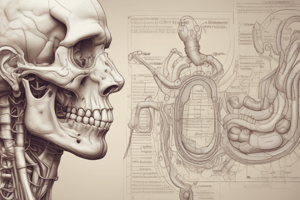Podcast
Questions and Answers
Red blood cells are shaped like a flat disc with a bulge in the center.
Red blood cells are shaped like a flat disc with a bulge in the center.
False (B)
Nerve cells contain long structures called axons to relay electrical impulses.
Nerve cells contain long structures called axons to relay electrical impulses.
True (A)
Intestinal lining cells are covered with microvilli to increase surface area for nutrient absorption.
Intestinal lining cells are covered with microvilli to increase surface area for nutrient absorption.
False (B)
Spermatocytes are one of the labeled structures in the microscopic view of the testis.
Spermatocytes are one of the labeled structures in the microscopic view of the testis.
Leydig cells are responsible for transporting oxygen in the blood.
Leydig cells are responsible for transporting oxygen in the blood.
Flashcards are hidden until you start studying
Study Notes
Cell Shapes and Functions
- Red blood cells have a flat disc shape with a central divot, allowing them to be "squishy" and squeeze through veins and arteries to transport gases and nutrients.
- This unique shape enables red blood cells to change shape without breaking, making them highly flexible.
Nerve Cells
- Nerve cells have long spindle-shaped axons that relay electrical impulses throughout the body, from the head to the lower extremities.
- The length of axons is essential for facilitating communication between different parts of the body.
Intestinal Lining
- Intestinal cells have numerous cilia, which increase their surface area and enable the absorption of more nutrients from food.
Anatomy of the Testis
- The testis contains various structures, including spermatocytes, spermatogonia, Sertoli cells, spermatids, Leydig cells, and seminiferous tubules.
- These structures work together to facilitate the development and maturation of sperm cells.
Studying That Suits You
Use AI to generate personalized quizzes and flashcards to suit your learning preferences.




